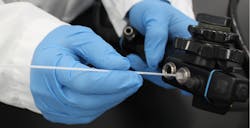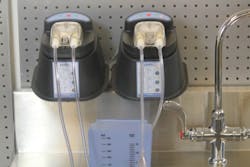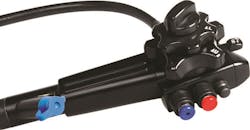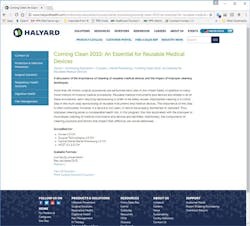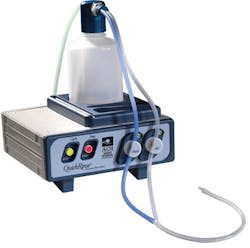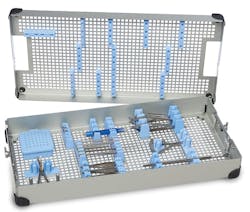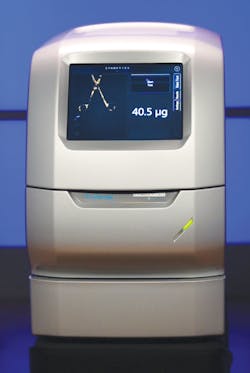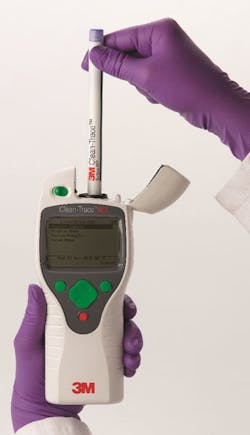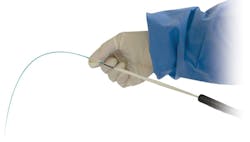It is common knowledge that a dirty surgical instrument cannot be sterilized. But effectively cleaning them prior to sterilization is no easy task. Failure to pre-clean instruments at the point of use, tight instrument turnover times, the growing complexity of surgical devices, lack of standardized processes in the operating room (OR) and central sterile/sterile processing department (CS/SPD) — and many other factors present challenges to effective cleaning. It’s not surprising that “inadequate cleaning of complex reusable instruments” took the number two spot on the ECRI Institute’s list of Top 10 Health Technology Hazards for 2017.1
In this article, Healthcare Purchasing News presents insights from industry leaders and experts on best practices and products for getting surgical instruments squeaky clean.
Instrument design
As procedures become more complex, so do the instruments used to perform them. Instruments featuring multiple components, tubes, lumens, hinges, narrow channels and other hard to reach areas present the greatest risk because they are not only difficult to clean and but also tough to inspect for cleanliness. The recent superbug outbreaks associated with contaminated duodenoscopes is a prime example of this issue.
“Adequate flushing of lumened devices is one of the greatest challenges to getting reusable instruments thoroughly clean before sterilization,” said Dan Gusanders, President of Pure Processing. “We estimate that 90 percent of sterile processing departments use syringes to manually flush cannulated instruments before putting them through the next washing/disinfection step. Due to the intense manual work of repeatedly filling, connecting and plunging the syringes and the time it takes for such a laborious process, steps can easily be inconsistent, skipped or forgotten. This is dangerous for patients because the hidden bioburden inside these long, dark channels can break free during use and infect the next patient.”
To address this issue, Pure Processing offers its FlexiPump Independent Flushing System, which automates the flushing process for reusable cannulated devices. It reduces manual repetitive labor, saves time, standardizes the process and meets Occupational Safety and Health Administration (OSHA) recommendations, all to help improve patient outcomes and worker safety. This economical Pure Processing system can be used in multiples to speed the pre-cleaning of flexibles scopes, rigid scopes, robotics devices, eye instruments, urology devices, orthopedic cannulas and much more. Each FlexiPump system can flush up to three channels simultaneously.
It all starts in the OR
The Centers for Disease Control and Prevention (CDC) recommend surgical instruments be presoaked or rinsed to prevent drying of blood and to soften or remove blood from the instruments.2 When OR staff members skip this step or don’t adequately pre-clean instruments following a procedure, it is harder for CS/SPD staff to clean them, adding time and complexity to the process.
“Instrument cleanliness starts in the OR,” said Marcus Super, Director of InstruSafe
Sales and Marketing for Summit Medical. “How staff begins the process of decontamination after the point of use can make a big difference in the effectiveness of cleaning. Instruments in high soil procedures require pre-cleaning during the procedure, after the procedure is complete and before transportation to decontamination.
“One suggestion would be to form a decontamination committee comprised of staff members from the OR (nurses/techs) and sterile processing,” added Super. “This will help build synergy between the departments while also identifying best practices for effective cleaning.”
“I have been in unique positions where I have been able to see the process from both the OR and SPD sides,” said Robert Turbett, President of Turbett Surgical. “In every situation, preventing bioburden is a must. To quote Deb Spratt, past president of the Association of periOperative Registered Nurses (AORN), ‘the acceptable percent of bio-burden occurrences is ZERO.’
“There are three people who must fail in order for bio-burden to occur — the scrub tech who didn’t complete point-of-use cleaning, the decontamination tech who didn’t wash it off, and the instrument specialist who missed it on inspection,” Turbett added. “In each event, the people responsible said they did not have enough time to complete their job to perfection.”
The Turbett Surgical Instrument POD simplifies the tedious steps in processing and delivery of instruments to the sterile field. The POD creates more time for key individuals in CS/SPD and the OR to focus on providing perfect instruments for surgery, while shortening the overall process. The POD filter features a built-in gasket (patent pending), meaning every patient gets a new seal.
“CS/SPD professionals need to stress the importance of pre-cleaning with the OR,” said Lindsay Brown, Clinical Educator, and CCSVP for Key Surgical. “When instruments arrive in SPD with dried blood and debris, it slows down overall productivity in decontamination by making it harder for trays to be turned over; especially when those trays are needed ASAP! Pre-cleaning is an absolute necessity.”
Key Surgical offers an education program that delivers complimentary learning labs in a convenient and engaging experience. Available through the company’s website https://www.keysurgical.com/education/, and accessible via a desktop/PC, tablet or smartphone, each lab is worth one CE credit (accredited through IAHCSMM and CBSPD) and focuses on important topics in sterile processing. The newest learning lab focuses on interdepartmental communication; specifically between the SPD and OR.
The right tools for the job
“Another challenge is not having the correct tools to get the job done,” said Ralph J. Basile, Vice President, HealthMark. “Studies have demonstrated that using a pulse flow washer is more effective in cleaning lumens, than manual processes alone. Having the right size brush is critical, and it’s critical that the brush be clean and does not cross contaminate the next device. We have introduced a line of single-use brushes that are designed to work every bit as well as reusable brushes, but are inexpensive enough to be disposed of after use.”
“Having the right sizes and styles of cleaning brushes will make the CS/SPD professionals’ job in decontamination easier and allows for thorough cleaning of instrumentation every time,” said Brown. “There are tools and training/education that exist which are designed to help take the guesswork out of finding the right sizes, as well as how to use them. Vendors play an important role in helping CS/SPD professionals get the tools they need.”
Basile adds that each CS/SPD must put into place a quality system to ensure they are producing a quality product, namely medical devices that are clean, disinfected/sterile and functionally ready for safe use on the next patient.
“One simple quality tool that each department should have in place is a flowchart of all of their key processes,” said Basile. “This helps all staff understand their process better and is helpful to identifying opportunities to improve. It’s also important to have tools for enhanced visual inspection, cleaning verification tests and the competency testing to demonstrate that CS staff are trained to get the job done right and understand why they are doing these various tasks properly each and every time.”
“CSS Directors should evaluate their tools and chemicals to ensure that staff has the best products available for them to do the job effectively,” said Robert B. Dybec, RN, MS, CPSN, CNOR, Nurse Manager, Operating Room, for Winthrop-University Hospital. “Many difficult-to-clean items such as endoscope accessories, which now must be tracked,3 can be replaced with disposable valves, which will reduce scope reprocessing time and reduce the risk of infection.”
RUHOF‘s ScopeValet GUARDIAN Disposable Valve Set eliminates the need for manual cleaning and reprocessing valves. The set is one-time use to prevent cross contamination and helps create consistent practices, reducing the potential for errors. Color—coded for easy identification, the GUARDIAN Valve Set contains one each of air/water, suction, and biopsy valves. Compatible for use in Olympus 140/160/180/190/240 and 260 endoscope series, the disposable valve set also enables compliance with a number of society guidelines.
Manufacturer IFUs and education
ECRI has found inattention to the cleaning steps within the reprocessing protocol is a contributing factor to the inadequate cleaning of complex reusable instruments. The organization recommends healthcare facilities “verify that comprehensive reprocessing instructions are available to staff and that all steps are consistently followed, including pre-cleaning of the device at the point of use.”1
“One of the greatest challenges in getting any surgical instrument or flexible scope clean prior to sterilization is compliance with manufacturers’ instructions for use (IFU) and continually performing the process the same way every time,” said Dybec. “There could be complacency and cutting corners to save time, which could lead to an improperly cleaned instrument. CSS technicians should receive initial education on the methods and steps in properly cleaning instruments and scopes. Competencies should be developed that are done yearly to keep staff current on the cleaning processes.”
“SPD managers need to devote time, money and attention to their pre-cleaning processes and staff,” said Gusanders. “Audit the pre-cleaning process and ask staff what the challenges are for them in performing the flushing process thoroughly, consistently, quickly, and with less repetitive motion injury. Dig into IFUs to understand reusable equipment capabilities, reprocessing requirements and physical limitations, and ensure that your process addresses these. It truly is the only way you will reduce patient infection and staff injury risks. Invest the time to improve the process and you will be helping your facility achieve optimal patient care and better hospital metrics over time.”
Halyard Health’s CE accredited course, Coming Clean 2010: An Essential for Reusable Medical Devices, features a discussion on the importance of cleaning reusable medical devices and the impact of improper cleaning techniques. In this program, the risks associated with the improper or incomplete cleaning of medical instruments and devices are identified. Additionally, the components of cleaning solutions and factors that impact their effective use are addressed. For more information visit http://www.halyardhealth.com/continuing-education/courses/sterile-processing/coming-clean-2010-an-essential-for-reusable-medical-devices.aspx.
Time is of the essence
Ensuring instruments are cleaned prior to sterilization is a tremendous challenge in the CS/SPD, where staff members are often pressured to quickly turn around instrument sets for subsequent use by the OR. The OR is the revenue-generating hub of any hospital — and time is money. But in today’s healthcare environment where healthcare organizations are increasingly compensated on value versus volume, patient safety has grown increasingly important to a hospital’s bottom line.
Although the CS/SPD can’t take shortcuts when it comes to instrument cleaning, there are still ways to streamline for greater efficiency. For example, David Salzberg, President of Advanced Optisurgical (AOI), recommends automating the rinsing process whenever possible.
The QuickRinse Instrument Rinse System from AOI is used to rinse lumened instruments and tubing. The QuickRinse frees up hands in the CS/SPD to perform other tasks, thereby greatly improving the speed and efficiency of reprocessing. It also provides consistent rinsing pressure and volume regardless of the operator, and eliminates hand fatigue associated with repetitive syringe use.
“Instrument turnover time is one of the greatest challenges sterile processing departments face when trying to effectively clean instruments before being sterilized,” said Super. “SPD technicians in the decontamination area don’t have the luxury of choosing what instruments are going to come back from the OR and when they will arrive, so having the proper process in both the OR and SPD is essential to effective cleaning prior to sterilization.”
Super notes that having instruments go through the automated washer in an organized, protected tray is essential to an effective and time-sensitive process. The Summit Medical InstruSafe Instrument Protection Trays, which are validated for use in automated washers, are highly perforated to allow detergent and water penetration, resulting in a successful wash cycle. Each tray is designed to position the working end of the instrument open and unobstructed by instrument on instrument contact, unlike instrument baskets that hold piles of instrument tangled into a mess.
The challenge of proteins
Thomas Overbey, Director of Marketing for Ultra Clean Systems, comments on the challenge of proteins when cleaning surgical instruments. He explains that once protein clears the decontamination side of sterile processing, and completes the sterilization process, any residual protein remaining is essentially baked (denatured) and left adhering to surgical instruments. As a result, none of these instruments can be considered sterile.
“Instrument-to-patient transmitted infections and prion diseases occur, in part, from residual protein,” said Overbey. “Therefore prion disease, as well as immunological effects in patients from protein-laden instruments, may be reduced if protein is considered as a benchmarked bioburden. If protein levels can be continually tracked and kept to an absolute minimum (ideally at zero micrograms), then it is possible to help reduce the risk of healthcare-acquired infections (HAIs) and prion diseases known as transmissible spongiform encephalopathies (TSEs).
“Establishing an instrument-sampling protocol is required to achieve reduced protein levels and can only be assured if testing is performed on a set timetable to reveal trends in cleaning variations,” he added. “A test can be started with all the input related to the instrument in under a minute.”
The ProReveal protein detection system from Ultra Clean Systems gathers information about surgical instruments and couples the data with results showing where and how much protein resides on a surgical instrument. Benchmarking and cleaning verification is easy with the ProReveal. Instrument sampling tests take only a few seconds to set up. The results are then stored so you can spot trends with your protein residuals and make informed decisions about your cleaning process.
Is it really clean?
Even when staff in the OR and CS/SPD follow all of the necessary steps for instrument cleaning, the question remains — is this item truly clean? Bioburden harboring dangerous microorganisms can be invisible to the naked eye. To address this issue, CS/SPD departments are turning to technologies that can help determine if an instrument has been thoroughly cleaned prior to sterilization.
“Sterile processing personnel are passionate people who try to do the best job possible. But when you are not able to see what you are cleaning it can be a difficult task,” said Shaun Sweeney, VP of Sales and Marketing for Cygnus Medical. “Biofilms are a notorious problem throughout healthcare settings but are especially threatening when they reside in or on surgical instruments. Unlike visible blood or other forms of gross contamination, a biofilm is not readily apparent to the naked eye.”
Janet Prust, Director of Standards and Global Business Development for the 3M Infection Prevention Division, points out that there are revised practice standards and guidelines for endoscope reprocessing that recommend routine cleaning verification monitoring with a rapid cleaning indicator.
“The biggest challenge is that it is very difficult to effectively and consistently clean devices and to know that the job has been satisfactorily accomplished,” said Prust. “Our historical approach to clean until it looks clean enough may just not be good enough! Consider the use of objective cleaning verification monitors. The standards make recommendations for cleaning verification for both automated and manual cleaning processes. Select a method that has been validated by the monitor manufacturer and one that provides a quantitative result to help better understand if technicians are accomplishing the task and your processes are compliant.”
The 3M Clean-Trace ATP Cleaning Monitoring System helps CS/SPD professionals quantify the cleanliness of a surface or lumen sample using Adenosine triphosphate (ATP) bioluminescence. It offers quantitative results that show the level of bioburden has been adequately reduced during the manual cleaning process.
“Process verification is an important step forward but more is needed,” added Sweeney. “If a biofilm is not dislodged it will not appear in the test results. Biofilms are generally not water soluable and will be undetectable with process monitoring such as ATP or protein swab kits if they are unable to be detached. The biofilm will not make contact with the reagents and will go undetected.”
Cygnus Medical has developed two new products that address the challenge of biofilms: the Dragontail microfiber channel brushes and Draco microfiber hand pads. In studies both products showed dramatically improved results over traditional methods. The Dragontail achieved a 4.9 log reduction on an endoscopic retrograde cholangiopancreatography (ERCP) suction channel compared to a 1.2 log reduction with the manufacturer’s nylon brush. In another study, the Draco Hand significantly outperformed urethane hand pads in the removal of biofilm (3.74 log reduction compared to a .63 log reduction).
References:
1. https://www.ecri.org/Resources/Whitepapers_and_reports/Haz17.pdf.
2. http://www.cdc.gov/hicpac/Disinfection_Sterilization/5_0cleaning.html.
3. Guideline for Processing Flexible Scopes. In: Guidelines for Perioperative Practice. Denver, CO: AORN, Inc; 2016:675-758.
About the Author
Kara Nadeau
Senior Contributing Editor
Kara Nadeau is Sterile Processing Editor for Healthcare Purchasing News.
